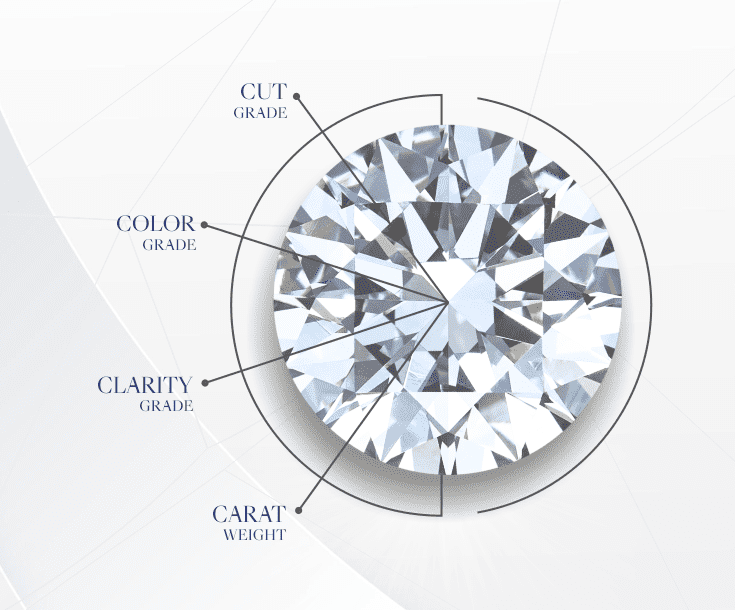The 4C’s of diamonds refer to the four characteristics that are considered the most important when determining a diamond’s quality and value:
- The first of the 4C’S Carat weight – this refers to the weight of the diamond, with one carat equalling 0.2 grams.
- The second of the 4C’S Cut – this refers to the quality of the diamond’s proportions, symmetry, and polish. A well-cut diamond will sparkle and reflect light well.
- The third of the 4C’S Clarity – this refers to the number and visibility of any inclusions or blemishes within the diamond. A higher clarity grade means fewer visible inclusions.
- The final C Color – this refers to the presence or absence of color within the diamond. Generally, the less color a diamond has, the more valuable it is considered to be. The Gemological Institute of America (GIA) uses a grading system that ranges from D (colorless) to Z (light yellow or brown).
These four characteristics work together to determine a diamond’s overall quality and value.
In the early 20th century, Robert M. Shipley, a former retail jeweler, undertook the task of professionalizing the American jewelry industry. To that end, he established GIA in 1931 to provide formal gemological training to aspiring jewelers. Shipley also established the American Gem Society (AGS), a professional guild whose members were GIA graduates.
Shipley standardized the diamond value terms to color, clarity, cut and carat weight and called them the 4Cs, a mnemonic device to help students and jewelers learn about, remember and explain the factors that determine a diamond’s value.
Under Shipley’s direction, the term 4Cs became part of industry vernacular through GIA course materials and advertising GIA prepared for AGS-member retailers.
Teaching Jewellers about the 4C’S
While it’s not known exactly when Shipley first began to teach the 4Cs at GIA because there are a few gaps in the dates or missing pages from his early course materials, the term appears in newspaper articles in the very early 40s — during the war years — by jewelers who had taken GIA courses. The earliest GIA course material in the archives at the Richard T. Liddicoat Gemological Library and Information Center in Carlsbad that mentions the 4Cs are from 1949. The text reads:
“These principal properties can be described as the writer [Shipley] first did in preparing advertising for AGS students as Color, Clarity, Cutting and Carat size − the 4C’s of Diamond Value.”
A GIA student helped produce the first chart used in GIA’s course materials about the 4Cs, “explaining how diamonds can be compared in value by measuring them with these four rulers.” The term also appeared in the AGS booklet “Diamonds” in 1951, and continues to be part of GIA and AGS materials.
Advertising Gia and De Beers [A Diamond is Forever]
Beginning in 1940, GIA collaborated with De Beers to create advertising designed to stimulate an interest in diamonds. Jewelers began to use the term 4Cs in news articles as early as 1941.
Later, Shipley arranged to have Gladys Babson-Hannaford, a lecturer for N. W. Ayer & Son (the U.S. advertising firm that represented De Beers), travel around the country to teach jewelers how to talk about the 4Cs to their customers. One of her tours kicked off in 1947 when she advised jewelers to “explain the four factors determining the value of a diamond. We call them the four Cs.”
N. W. Ayer & Son wrote “Secrets of the Diamond Expert” for The Jewelers’ Circular-Keystone (now JCK magazine) in 1954. It focused on the 4Cs and the material presented seems to have evolved from the talks given in 1947. It was meant as a “speech for jewelers to use to address consumer groups,” according to a secondary headline in the article.
While De Beers helped with the advertising campaigns that involved the 4Cs, it was not until August of 1962, when the term had become popular, that De Beers adopted the term 4Cs in its national magazine advertising campaign. It stopped using the term purity and started using Shipley’s term clarity (a word starting with ‘c’).
Today, the 4C’ of Diamond Quality is the universal phrase for referring to the four qualities that determine the value of any diamond, anywhere in the world. This simple mnemonic device, along with the grading standards and practices GIA also developed, means that diamond quality can be communicated in a universal language so diamond purchasers know exactly what they are buying.
A Diamond is Forever
“A Diamond is Forever” is a slogan that was created in 1947 by the advertising agency N.W. Ayer & Son for De Beers, the world’s largest diamond mining and trading company. It has served as one of the most successful marketing campaigns in history. For many people, this slogan has become synonymous with the idea that diamonds are a symbol of everlasting love. The slogan is still used by De Beers to this day, and it has influenced the way in which many people view diamonds.
Over a billion years old, a diamond is one of the closest things to Forever that we can hold in our hands. And in a world of short-term fixes where so much is disposable, symbols of enduring strength are more important than ever.
